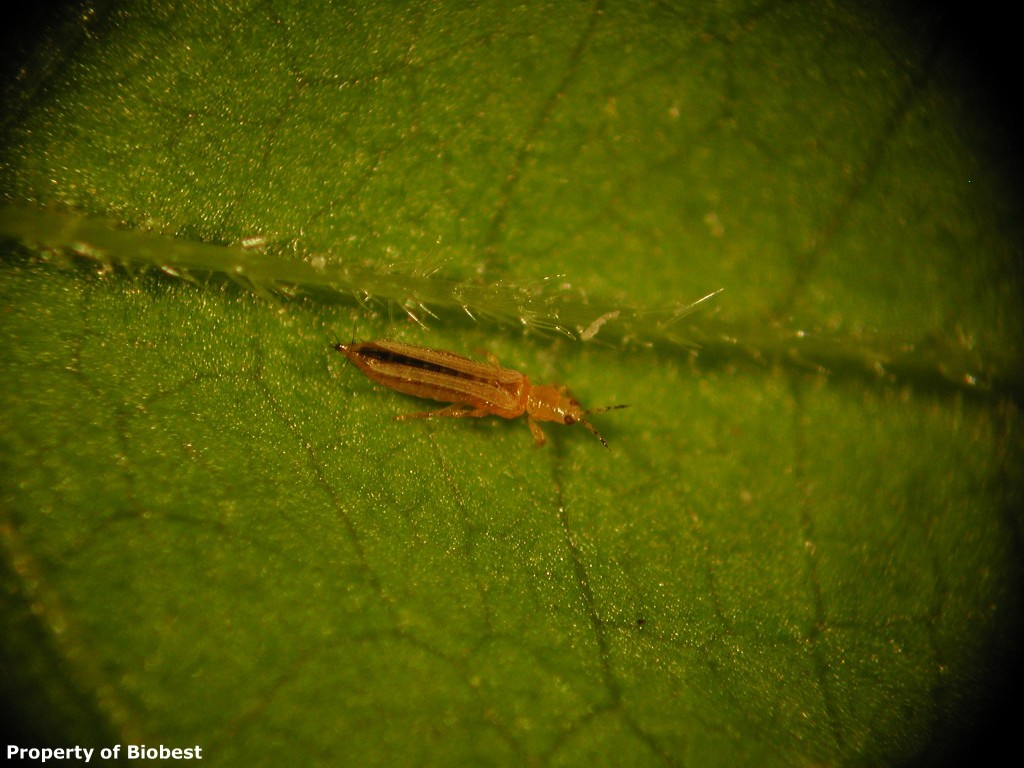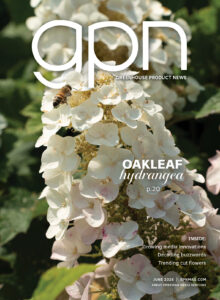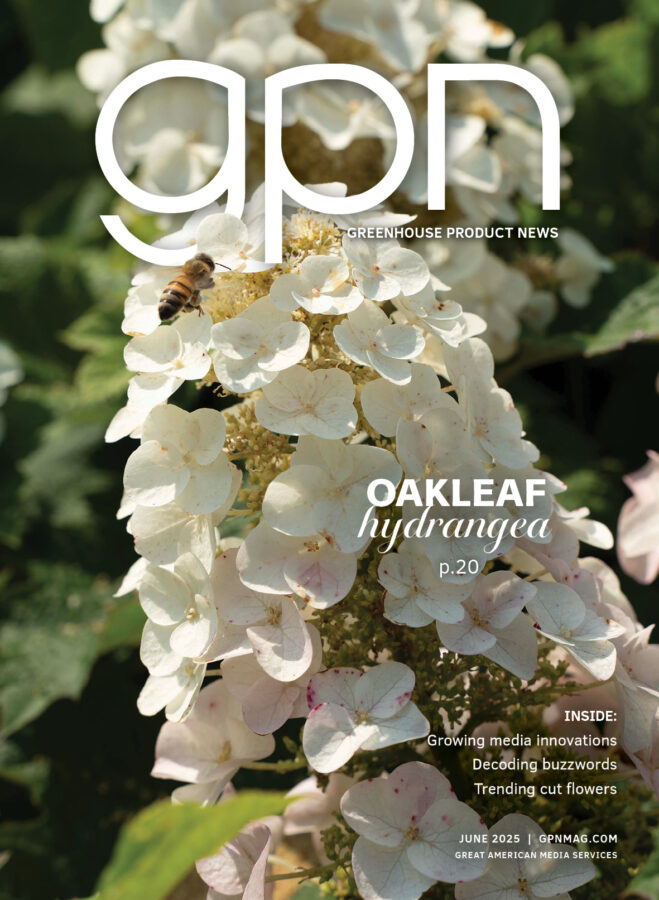
Are Thrips Still Bugging You?
Late in 2006, and certainly during 2007, Western flower thrips (Frankliniella occidentalis) caused a lot of headaches for growers, not only in the United States and Canada, but at a global level. It became clear that some of the pesticides that had been very effective were having trouble with resistance development. With the global trade of propagative materials, resistant populations of pest can be distributed very quickly around the globe.
Since then more and more growers have been looking at alternative solutions to control their thrips problems. Just like greenhouse vegetable growers did 30 years ago, many ornamental growers considered biological control agents (BCAs) as an option. In the last six to seven years, biological control for thrips has developed into a very solid, successful system. However, it is important to start a biological control program on the right foot, especially with thrips, because the aim is not fixing a problem, but preventing it. We are no longer trying to eradicate thrips (as this was not successful), but get the population to acceptable low levels. So what does a program look like for thrips control?
Understanding Thrips Life Cycle
In order to be successful, it is important to understand the life cycle of thrips and their behavior. How do they respond to different stages of the crops we grow?
Thrips actually lay eggs in the cell tissue of plants, so that stage is very difficult to affect. The immature and adult stages actually take place on the plants and are exposed. The pupa stage often takes place in the soil in the pot or underneath the bench or on the floor.
It is important to understand what part of the life cycle of thrips is affected by which BCA. Amblyseius cucumeris and Amblyseius swirskii, two of the most commonly used and important BCAs in the battle against thrips, are only able to control larval stage 1. On larval stage 2 these BCAs sometimes make an attempt attack, but in reality the larva is already too large for the BCAs to do any serious damage. With this knowledge, we understand that the window of opportunity is only a matter of days in the overall life cycle of thrips. It also means that in order to control thrips with these two predatory mites, they need to be present early on in the crop. Often technical crop protection specialists are contacted later in the spring when there is already a healthy established adult thrips population and growers have problems controlling this population. This is definitely not a good start-time for biological control program implemenation.
Another factor that affects thrips in their development is temperature. With increased temperature, the life cycle of thrips goes faster. At 68° F it takes approximately 18 days from egg to adult as compared to nine to 10 days at 86° F. The stage of the crop also affects the development of the population. In the vegetative growing stage, thrips females will lay fewer eggs as compared to when flowers open on plants and there is pollen available. This can go from three to four eggs per female per day to 14 to 15 eggs per day. Needless to say, when thrips get going, the going gets tough.
Clean Cuttings and Young Plants
Biological control for thrips starts even before plugs, plants or cuttings arrive at the greenhouse. It is best to assume that thrips are going to be present on propagation material that comes into your greenhouse.
There is no use blaming cutting producers, the rooting station or others for problems, because zero tolerance is hard, if not impossible, to achieve.
It has to be understood that a lot is done to try to minimize ‘hitchhikers’, but just like the growers of the end product, cuttings producers are dealing with the same issues around resistant pest populations.
Recently a study was done in Canada by a student at the University of Guelph. A year-round potted chrysanthemum grower was followed for eight months and samples were taken every two weeks of his incoming cuttings of five different cultivars. Samples were washed out in the lab and not one sample was free of thrips, and in some samples three adult thrips per cuttings were found. This was visually almost undetectable.
The understanding of what a ‘clean’ cutting or propagative material means is also changing. Historically it meant no pest problems, and the word “zero tolerance” was, and still is, used often. However, with more and more ornamental growers adapting BCAs into their pest management programs, pesticide residues are also a growing concern.
Some pesticides can have negative residual effects on BCAs, which make a start with BCAs more challenging. As an example, many poinsettia growers struggled with whitefly in 2012, right from the start of the crop. Cuttings arrived with higher levels than previous years, but when tissue samples from 10 different growers in Canada were sent to a lab and tested for residue testing, they found no less than 24 different active ingredients of insecticides and an additional 20 active ingredients of fungicides.
More and more cuttings producers and rooting facilities are implementing BCAs or BCA-friendly pest management programs for their customers who are implementing BCAs in their pest management programs. This last part will also help to avoid further erosion of effective pesticide tools. Overuse of pesticides in stock plants in order to try to achieve zero tolerance can result in pesticide resistance and further erosion of the pesticides that are (still) effective, which won’t help when we really need them.
Thrips and Viruses
It is well known that Western flower thrips are capable of transmitting TSWV and INSV. This is often mentioned as a concern when considering biological control. It is also in discussions around zero tolerance and thrips in propagation and production of cuttings. However, there are is lot of misunderstanding by many growers on the facts around
vectoring viruses. Adult thrips feeding on a TSWV-infected plant and then going on to a healthy plant will not vector the virus. As a matter of fact, once adults, they will never transmit the virus. In order for the virus to be vectored, thrips need to be on an infected plant during the larval stages in order to acquire the virus. Once that larva has completed its life cycle on that plant, pupates and then becomes an adult thrip, it can then transmit the virus for its entire life as an adult. When Amblyseius species are used to control thrips, most of the larvae do not even make it to the adult stage, and therefore limit the amount of new adults emerging that actually carry the virus. It is also known that agitating adult thrips (certain pesticides and extracts can do this) can increase the movement of adult thrips, including the ones carrying the virus, resulting in more plants being infected.
Implementing BCAs for Thrips Control: Where to Start
As mentioned earlier, the best way of controlling thrips is to not give the population the chance to establish. This means starting early in the crop cycle is important managing thrips.
A few BCAs that are increasingly used early on in the crop cycle are entomopathogens such as Botanigard (Beauveria bassiana), Preferal and NoFly (Paecilomyces fumosoroseus). These products are sometimes referred to as ‘Powdery Mildew for insects.’ Another BCA that is used increasingly in combination with these products is Steinernema feltiae, a nematode that affects fungus gnats and thrips. In order for these products to be effective there are a few things that need to be taken into consideration. It is absolutely critical that there is contact between these products and our target, thrips. No contact means no efficacy. The other points that are important are temperature and humidity. Studies in Europe on cut chrysanthemum have shown that applying short bursts of mist once an hour for several hours after application increases efficacy with these products. Looking at these conditions, these products fit well into propagation where these conditions are created.
These entomopathogens and nematodes are applied in several ways. They can be applied through spray equipment, but keep in mind that the fine filters need to be removed when the stock solution is agitated. This is to avoid filtering out the nematodes and keep the nematodes evenly distributed in the solution. Nematodes sink at a rate of 1 inch every three minutes. Also keep the pressure below 300 psi to avoid crushing the nematodes. At some larger operations spray booms have been adjusted with a separate line with spray tips that have the filters permanently removed. Some of these highly automated operations extend the use of these products further than just the propagation and are successful managing their thrips. Keys to making this successful are consistent and frequent applications (once a week in winter, once every five days summer) as well as timing the applications later in the day or even better during the night. Nematodes, especially, will benefit from applications in the dark.
Another application that has become a commonly used technique is dipping and submerging unrooted as well as rooted cuttings and seed propagation trays at point of entry. As mentioned above, it is important for these products to have contact. There is no better contact than when a tray is completely submerged into a solution. In addition to these products, often a biofungicide is added to the solution. A risk factor that has to be taken into consideration is the possible spread of disease. So far it seems that the benefits of an application such as this have outweighed the risks involved. This technique is something that can be implemented by any grower, whether working with a traditional spray program or a program that continues with BCAs. One note that needs to be made is to not use Botanigard ES for this application, as it has shown to be phyto toxic for a number of plant species. Use only Botanigard WP for this method of application.
Continuing with BCAs
The next step in ornamental production is, in most cases, at the point of transplanting. This is when Amblyseius cucumeris is released into the crop. In some crops that require a longer propagation time such as African violets and cyclamen, Amblyseius is released in the propagation stage as well. Amblyseius cucumeris has been used successfully for more than two decades in the vegetable industry. However a major adjustment was made three years ago to accommodate the ornamental crops. Amblyseius cucumeris is a small predatory mite that is often applied into the crop in so-called breeding systems (ABS=Amblyseius Breeding System). These little breeding systems are literally an extension of the production of these mites at the biocontrol company, and they release these mites for at least four weeks, but often much longer. Every day some mites leave these small sachets to ‘hunt’ for thrips larvae. The critical point with these mites is the distribution, as mites do not fly. The main difference between greenhouse vegetable crops and ornamental crops is the distance between the plants, as it is critical for mites to get from one plant to the next. The larger breeding sachets that are used in greenhouse vegetable pepper and cucumber operations were not suitable or cost effective to be used in ornamentals.
For example, every hanging basket needs a breeding sachet. This has led to the development of a mini Amblyseius cucumeris breeding sachet. This was a major improvement for the development of thrips biocontrol in ornamentals. The interesting part is that since then even the greenhouse vegetable growers have used these mini sachets, as they also experienced faster establishment of the predatory mites into the crop.
In some situations it can be an advantage to choose another Amblyseius spp., named Amblyseius swisrkii. This predatory mite is very similar in appearance, but has two advantages over Amblyseius cucumeris. It performs very well at higher temperatures (summer months) and in addition to thrips, it also consumes whitefly eggs. However, it is significantly more expensive when compared to Amblyseius cucumeris, so it is often used in higher value crops or when whitefly is a significant enough pest problem.
Both Amblyseius species can also use pollen as a food source. This means that when flowers start to show up later in the crop cycle, this can be supplemental food for these mites, especially if thrips levels are still extremely low.
BCAs That Multitask
Often fungus gnats and shore flies need to be considered in a pest management program. Many growers using a BCA program release a predatory mite, Hypoaspis miles (10 mites per square foot), and a rove beetle, Atheta coriaria (0.1 to 0.2 per square foot). Both of these predators make their home in the top layer of the soil and in and around the pot. This is also the spot where thrips like to pupate. Because both of these are considered generalist predators (they are not picky in what they eat), thrips pupae are also on the menu. This is certainly not their main target and thrips control solely with these two would not succeed, but this is what is often called a side effect of these two predators. These predators can also be released in propagation, and a second application is often applied after transplanting.
For the Advanced Biocontrol Grower and Longer Term Crops
There is one BCA that is left to talk about for thrips control Orius insidiosus. This little bug is a true thrips killer. It is known to kill up to 80 adult thrips per day, even though it only feeds on a few of those 80. It is used around the world by greenhouse sweet pepper growers. It is also considered a generalist, so other things are also on its menu. However, there are some reasons why it has limited use in ornamental crops. The first part is that Orius has a long development time. My mentor in biocontrol years ago named Orius “the steam locomotive” of the BCAs. It takes at least two generations to get the population going, and that takes 60 to 70 days. They are also known to go into diapause under short day length. Releases are usually not recommended until March. When you add another 60 to 70 days to spring crop production, we are near the end of the crop. Establishing a population of Orius in spring ornamental crops is not likely due to the quick turnover of crops in the greenhouse as well.
Having mentioned this, there are growers who continue after their spring season with crops such as cyclamen, chrysanthemums and other thrips susceptible crops. Especially if you are growing these crops and have experienced trouble keeping the lid on your thrips population, it might be a consideration to implement a pepper banker plant system to help Orius to establish. This system is not a standalone system and requires dedication and long-term planning to make it work. For example, plants need to get seeded late October or early November to start Orius releases in March. It is not a system for every crop situation and needs to be considered carefully to avoid disappointing results. Consider talking to someone experienced with this system before implementing into your pest management program.
Conclusion
When considering biological control for thrips it is important to understand them. Starting a program that is proactive and early in the production process is critical. Communicating with the source of propagation material is very helpful to understanding what to expect when plants or cuttings arrive at the door. Don’t expect zero tolerance. Plan your program ahead of time with your source of BCAs. Timing is important, and BCAs need to be produced and prepared for their new home at your greenhouse, so they can do their job properly.
For many growers, disappointing results controlling thrips with pesticides was a reason to look at other options, which in many cases was biological control. Many of these growers have been successful by doing so. However, one thing to keep in mind when making a switch to a biocontrol for thrips is to not forget about the other pest problems. Doing so could jeopardize your overall biocontrol system. For example, aphids are fairly easy to control in traditional pest management programs. Once using biocontrol for thrips, there are limitations on what can be used as far as pesticides goes in order not to harm your BCAs for thrips control. Growers who are most successful with biological control are those growers using BCAs as their first line of defense, not excluding compatible pesticides (preferable as spot treatments).









 Video Library
Video Library 


















